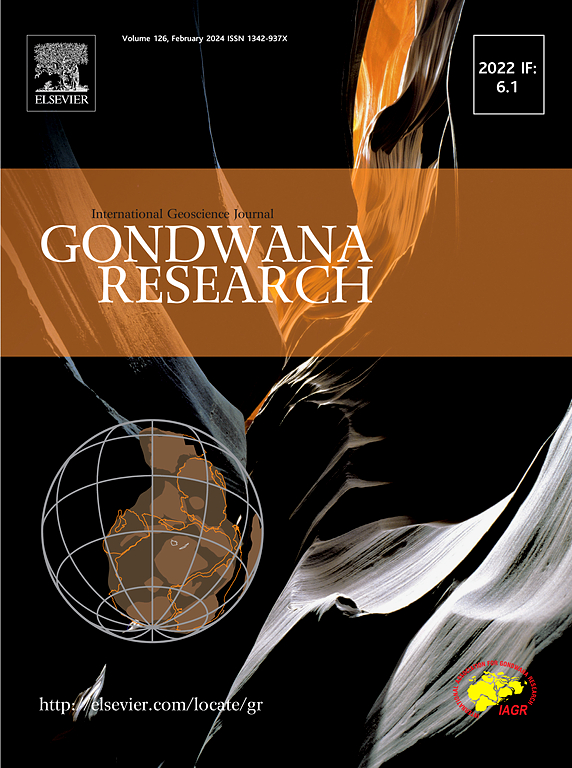Paleoproterozoic to Cambro-Ordovician crustal evolution in the northern Indian margin: Evidence from whole-rock geochemical, zircon U–Pb, Hf and O isotope signatures in the granitoids of Arunachal Himalaya, Northeast India
IF 7.2
1区 地球科学
Q1 GEOSCIENCES, MULTIDISCIPLINARY
引用次数: 0
Abstract
The northern margin of the Indian continental plate had undergone multiple tectonic events associated with the supercontinent assemblies and breakups before the Cenozoic collision of the Indian and Eurasian plates. Whole-rock geochemical, zircon U–Pb geochronology, Lu–Hf and O isotopic study of the granites and granite gneisses exposed in the west Kameng and Subansiri regions of Arunachal Himalaya has been carried out to understand the crustal evolution of the northern Indian margin during the Paleoproterozoic to Cambro-Ordovician. Bomdila granite gneisses of the west Kameng yielded zircon U–Pb ages of 1827 ± 24 Ma and 1753 ± 8 Ma, with εHf values ranging from –7.3 to +1.0 and δ18O values of 6.38–10.44 ‰, indicating a heterogeneous source derived from recycled crust and juvenile components with a significant incorporation of sediments. Geochemical signatures indicate a continental arc setting during the Columbia assembly. Tonian magmatism in the Dirang area (879–799 Ma) and the Ziro Valley (886 ± 13 Ma) of Subansiri area represent the eastern Himalayan vestiges of the Tonian crust associated with the Rodinia assembly. Bomdila granite yielded a younger emplacement age of 517 ± 4 Ma with εHf values between –9.3 to +0.4, indicating mixed sources with dominant recycled crustal and minor juvenile components. Ziro granite (509 ± 26 Ma) and Potin granite gneiss (520 ± 3 Ma) of Subansiri area yielded subchondritic εHf values of –9.6 to –6.6 and –16.8 to –3.6 respectively, indicating a recycled crustal-derived heterogeneous source. The zircons of the Bomdila granite, Ziro granite, and Potin granite gneiss show similar ranges of δ18O values: 6.34–8.78 ‰, 6.60–9.14 ‰ and 6.63–9.80 ‰ respectively, suggesting a moderate to high incorporation of sediments in the generation of these rocks during the widespread Cambro-Ordovician magmatism in the northern margin of India.

在新生代印度板块与欧亚板块碰撞之前,印度大陆北缘经历了与超大陆合并和分裂相关的多次构造事件。卡蒙西部庞迪拉花岗片麻岩的锆石U-Pb年龄分别为1827 ± 24 Ma和1753 ± 8 Ma, εHf值为-7.3 ~ +1.0,δ18O值为6.38 ~ 10.44 ‰,表明其为非均质源,主要来源于地壳再循环和幼年成分,并有明显的沉积作用。地球化学特征表明哥伦比亚组合期间存在大陆弧背景。迪朗组托尼亚岩浆活动(879 ~ 799 Ma)和苏班斯里地区Ziro谷(886 ± 13 Ma)代表了与Rodinia组合相关的东喜马拉雅托尼亚地壳遗迹。Bomdila花岗岩的侵位年龄较年轻,为517 ± 4 Ma, εHf值在-9.3 ~ +0.4之间,显示出以再循环地壳成分为主,幼代成分较少的混合源。Subansiri地区Ziro花岗岩(509 ± 26 Ma)和Potin花岗岩片麻岩(520 ± 3 Ma)的亚球粒状εHf值分别为-9.6 ~ -6.6和-16.8 ~ -3.6,表明其为再循环壳源非均质源。Bomdila花岗岩、Ziro花岗岩和Potin花岗岩片麻岩的锆石δ18O值范围相似,分别为6.34 ~ 8.78 ‰、6.60 ~ 9.14 ‰和6.63 ~ 9.80 ‰,表明在印度北缘广泛存在的寒武-奥陶系岩浆活动期间,这些岩石的形成过程中存在中等至高度的沉积作用。
本文章由计算机程序翻译,如有差异,请以英文原文为准。
求助全文
约1分钟内获得全文
求助全文
来源期刊

Gondwana Research
地学-地球科学综合
CiteScore
12.90
自引率
6.60%
发文量
298
审稿时长
65 days
期刊介绍:
Gondwana Research (GR) is an International Journal aimed to promote high quality research publications on all topics related to solid Earth, particularly with reference to the origin and evolution of continents, continental assemblies and their resources. GR is an "all earth science" journal with no restrictions on geological time, terrane or theme and covers a wide spectrum of topics in geosciences such as geology, geomorphology, palaeontology, structure, petrology, geochemistry, stable isotopes, geochronology, economic geology, exploration geology, engineering geology, geophysics, and environmental geology among other themes, and provides an appropriate forum to integrate studies from different disciplines and different terrains. In addition to regular articles and thematic issues, the journal invites high profile state-of-the-art reviews on thrust area topics for its column, ''GR FOCUS''. Focus articles include short biographies and photographs of the authors. Short articles (within ten printed pages) for rapid publication reporting important discoveries or innovative models of global interest will be considered under the category ''GR LETTERS''.
 求助内容:
求助内容: 应助结果提醒方式:
应助结果提醒方式:


